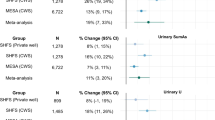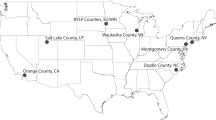Abstract
Element deficiencies and excesses play important roles in non-communicable disease aetiology. When investigating their roles in epidemiologic studies without prospective designs, reverse-causality limits the utility of transient biomarkers in cases. This study aimed to investigate whether surrogate participants may provide viable proxies by assessing concentration correlations within households. We obtained spot urine samples from 245 Tanzanian and Kenyan adults (including 101 household pairs) to investigate intra-household correlations of urinary elements (As, Ba, Ca, Cd, Co, Cs, Cu, Fe, Li, Mn, Mo, Ni, Pb, Rb, S, Se, Sr, Tl, V and Zn) and concentrations (also available for: Bi, Ce, Sb, Sn and U) relative to external population-levels and health-based values. Moderate-strong correlations were observed for As (r = 0.65), Cs (r = 0.67), Li (r = 0.56), Mo (r = 0.57), Se (r = 0.68) and Tl (r = 0.67). Remaining correlations were <0.41. Median Se concentrations in Tanzania (29 µg/L) and Kenya (24 µg/L) were low relative to 5738 Canadians (59 µg/L). Exceedances (of reference 95th percentiles) were observed for: Co, Mn, Mo, Ni and U. Compared to health-based values, exceedances were present for As, Co, Mo and Se but deficiencies were also present for Mo and Se. For well correlated elements, household members in East African settings provide feasible surrogate cases to investigate element deficiencies/excesses in relation to non-communicable diseases.
This is a preview of subscription content, access via your institution
Access options
Subscribe to this journal
Receive 6 print issues and online access
$259.00 per year
only $43.17 per issue
Buy this article
- Purchase on Springer Link
- Instant access to full article PDF
Prices may be subject to local taxes which are calculated during checkout


Similar content being viewed by others
References
Ho E. Zinc deficiency, DNA damage, and cancer risk. J Nutr Biochem. 2004;15:572–8.
Ames BN, Wakimoto P. Are vitamin and mineral deficiencies a major cancer risk? Nat Rev Cancer. 2002;2:694–704.
Navas-Acien A, Sharrett AR, Silbergeld EK, Schwartz BS, Nachman KE, Burke TA, et al. Arsenic exposure and cardiovascular disease: a systematic review of the epidemiologic evidence. Am J Epidemiol. 2005;162:1037–49.
Navas-Acien A, Silbergeld EK, Pastor-Barriuso R, Guallar E. Arsenic exposure and prevalence of type 2 diabetes in US adults. J Am Med Assoc. 2008;300:814–22.
WHO. Exposure To Arsenic: A Major Public Heath Concern. Public Health and Environment World Health Organization. Geneva, Switzerland. Available: http://www.who.int/ipcs/features/arsenic.pdf; 2010.
WHO. Exposure To Cadmium: A Major Public Health Concern. Public Health and Environment. World Health Organization. Geneva, Switzerland. Available: http://www.who.int/ipcs/features/cadmium.pdf; 2010.
WHO. Exposure To Lead: A Major Public Health Concern. Public Health and Environment. World Health Organization. Geneva, Switzerland. Available: http://www.who.int/ipcs/features/lead..pdf; 2010.
IARC.. Arsenic, metals, fibers and dusts. IARC Monogr Eval Carcinog Risks Hum. 2012;100C:41–85.
Hughes DJ, Duarte-Salles T, Hybsier S, Trichopoulou A, Stepien M, Aleksandrova K, et al. Prediagnostic selenium status and hepatobiliary cancer risk in the European Prospective Investigation into Cancer and Nutrition cohort. Am J Clin Nutr. 2016;104:406–14.
Middleton DR, Watts MJ, Hamilton E, Fletcher T, Leonardi GS, Close R, et al. Prolonged exposure to arsenic in UK private water supplies: Toenail, hair and drinking water concentrations. Environ Sci. 2016;18:562–74.
Greenberg RS, Liff JM, Gregory H, Brockman J. The use of interviews with surrogate respondents in a case–control study of oral cancer. Yale J Biol Med. 1986;59:497.
Nelson LM, Longstreth Jr W, Koepsell TD, Van Belle G. Proxy respondents in epidemiologic research. Epidemiol Rev. 1990;12:71–86.
Debanne SM, Petot GJ, Li J, Koss E, Lerner AJ, Riedel TM, et al. On the use of surrogate respondents for controls in a case–control study of Alzheimer’s disease. J Am Geriatr Soc. 2001;49:980–4.
Munishi MO, Hanisch R, Mapunda O, Ndyetabura T, Ndaro A, Schuz J, et al. Africa’s oesophageal cancer corridor: do hot beverages contribute? Cancer Causes Control. 2015;26:1477–86.
Middleton D, Watts M, Hamilton E, Ander E, Close R, Exley K, et al. Urinary arsenic profiles reveal substantial exposures to inorganic arsenic from private drinking water supplies in Cornwall, UK. Scientific Reports. 2016.
Levine L, Fahy JP. Evaluation of urinary lead concentrations. I. The significance of the specific gravity. J Ind Hyg Toxicol. 1945;27:217–23.
RCoreTeam. R: A language and environment for statistical computing. R Foundation for Statistical Computing, Vienna, Austria. URL https://www.R-project.org/; 2016.
RStudioTeam. RStudio: Integrated Development for R. RStudio, Inc., Boston, MA URL http://www.rstudio.com/; 2015.
CDC. Fourth national report on human exposure to environmental chemicals, updated tables2017. Centers for Disease ControlPrevention Atlanta, GA: Department of Health and Human Services; 2017.
Canada H Second Report on Human Biomonitoring of Environmental Chemicals in Canada. Ottawa, ON, Canada:Health Canada. 2013. Available: https://www.canada.ca/en/health-canada/services/environmental-workplace-health/reports-publications/environmental-contaminants/second-report-human-biomonitoring-environmental-chemicals-canada-health-canada-2013.html; 2013.
Morton J, Tan E, Leese E, Cocker J. Determination of 61 elements in urine samples collected from a non-occupationally exposed UK adult population. Toxicol Lett. 2014;231:179–93.
Hoet P, Jacquerye C, Deumer G, Lison D, Haufroid V. Reference values and upper reference limits for 26 trace elements in the urine of adults living in Belgium. Clin Chem Lab Med. 2013;51:839–49.
Hays SM, Aylward LL, Gagné M, Nong A, Krishnan K. Biomonitoring equivalents for inorganic arsenic. Regul Toxicol Pharmacol. 2010;58:1–9.
Hays SM, Macey K, Nong A, Aylward LL. Biomonitoring equivalents for selenium. Regul Toxicol Pharmacol. 2014;70:333–9.
Hays SM, Macey K, Poddalgoda D, Lu M, Nong A, Aylward LL. Biomonitoring equivalents for molybdenum. Regul Toxicol Pharmacol. 2016;77:223–9.
Hays SM, Nordberg M, Yager JW, Aylward LL. Biomonitoring equivalents (BE) dossier for cadmium (Cd)(CAS No. 7440-43-9). Regul Toxicol Pharmacol. 2008;51:S49–S56.
ACGIH. American Conference of Government Industrial Hygienists (ACGIH). Documentation of biological exposure indices. 7th edition. Cincinnati (OH): ACGIH Worldwide; 2001.
Hays S, Becker R, Leung H, Aylward L, Pyatt D. Biomonitoring equivalents: a screening approach for interpreting biomonitoring results from a public health risk perspective. Regul Toxicol Pharmacol. 2007;47:96–109.
Middleton DR, Watts MJ, Lark RM, Milne CJ, Polya DA. Assessing urinary flow rate, creatinine, osmolality and other hydration adjustment methods for urinary biomonitoring using NHANES arsenic, iodine, lead and cadmium data. Environ Health. 2016;15:68.
Ben-Hamouda N, Charrière M, Voirol P, Berger MM. Massive copper and selenium losses cause life-threatening deficiencies during prolonged continuous renal replacement. Nutrition. 2017;34:71–5.
Pennington J, Schoen S, Salmon G, Young B, Johnson R, Marts R. Composition of core foods of the US food supply, 1982–1991: III. Copper, manganese, selenium, and iodine. J Food Compos Anal. 1995;8:171–217.
Benemariya H, Robberecht H, Deelstra H. Daily dietary intake of copper, zinc and selenium by different population groups in Burundi, Africa. Sci Total Environ. 1993;136:49–76.
Acquavella JF, Alexander BH, Mandel JS, Gustin C, Baker B, Chapman P, et al. Glyphosate biomonitoring for farmers and their families: results from the Farm Family Exposure Study. Environ Health Perspect. 2004;112:321.
Kamangar F, Chow WH, Abnet CC, Dawsey SM. Environmental causes of esophageal cancer. Gastroenterol Clin North Am. 2009;38:27–57.
Jaskiewicz K, Marasas W, Rossouw J, Van Niekerk F, Tech E. Selenium and other mineral elements in populations at risk for esophageal cancer. Cancer . 1988;62:2635–9.
Wei WQ, Abnet CC, Qiao YL, Dawsey SM, Dong ZW, Sun XD, et al. Prospective study of serum selenium concentrations and esophageal and gastric cardia cancer, heart disease, stroke, and total death. Am J Clin Nutr. 2004;79:80–5.
Qiao YL, Dawsey SM, Kamangar F, Fan JH, Abnet CC, Sun XD, et al. Total and cancer mortality after supplementation with vitamins and minerals: follow-up of the Linxian General Population Nutrition Intervention Trial. J Natl Cancer Inst. 2009;101:507–18.
Steevens J, van den Brandt PA, Goldbohm RA, Schouten LJ. Selenium status and the risk of esophageal and gastric cancer subtypes: the Netherlands cohort study. Gastroenterology. 2010;138:1704–13.
Hashemian M, Poustchi H, Abnet CC, Boffetta P, Dawsey SM, Brennan PJ, et al. Dietary intake of minerals and risk of esophageal squamous cell carcinoma: results from the Golestan Cohort Study. Am J Clin Nutr. 2015;102:102–8.
McCormack VA, Menya D, Munishi MO, Dzamalala C, Gasmelseed N, Leon Roux M, et al. Informing etiologic research priorities for squamous cell esophageal cancer in Africa: a review of setting-specific exposures to known and putative risk factors. Int J Cancer. 2016;140:259–71.
Schaafsma T, Wakefield J, Hanisch R, Bray F, Schuz J, Joy EJ, et al. Africa’s Oesophageal Cancer Corridor: geographic variations in incidence correlate with certain micronutrient deficiencies. PLoS One. 2015;10:e0140107.
Joy EJM, Broadley MR, Young SD, Black CR, Chilimba ADC, Ander EL, et al. Soil-type influences crop mineral composition in Malawi. Sci Total Environ. 2015;505:587–95.
Joy EJM, Ander EL, Young SD, Black CR, Watts MJ, Chilimba ADC, et al. Dietary mineral supplies in Africa. Physiol Plant. 2014;151:208–29.
Aylward LL, Hays SM, Smolders R, Koch HM, Cocker J, Jones K, et al. Sources of variability in biomarker concentrations. J Toxicol Environ Health Part B. 2014;17:45–61.
CDC. Lead Biomonitoring Summary. National Biomonitoring Program. Centers for Disease Control and Prevention (CDC). Available: https://www.cdc.gov/biomonitoring/biomonitoring_summaries.html; 2017.
Buchet JP, Lauwerys R, Roels H. Comparison of the urinary excretion of arsenic metabolites after a single oral dose of sodium arsenite, monomethylarsonate, or dimethylarsinate in man. Int Arch Occup Environ Health. 1981;48:71–9.
Orloff K, Mistry K, Metcalf S. Biomonitoring for environmental exposures to arsenic. J Toxicol Environ Health, Part B. 2009;12:509–24.
Hurst R, Siyame EW, Young SD, Chilimba AD, Joy EJ, Black CR, et al. Soil-type influences human selenium status and underlies widespread selenium deficiency risks in Malawi. Sci Rep. 2013;3:1425.
Acknowledgements
The authors thank Dr. Graham Byrnes and Liacine Bouaoun for statistical discussions and advice.
Funding
Funding was received from an NIH grant (R21CA191965) with support from BGS Global and the Centre for Environmental Geochemistry. The work reported was undertaken during the tenure of a Postdoctoral Fellowship from the International agency for Research on cancer, partially supported by the European Commission FP7 Marie Curie Actions—People—Co-funding of regional, national and international programmes (COFUND) and a UICC IARC Development Fellowship.
Author information
Authors and Affiliations
Corresponding author
Ethics declarations
Conflict of interest
The authors declare that they have no conflict of interest.
Ethical approval
Ethical approval was granted at IARC (IEC 14–15), in Tanzania (NIMR/HQ/R.8a) and Moi University in Kenya (IREC 000921). Informed consent was obtained from all participants.
Electronic supplementary material
Rights and permissions
About this article
Cite this article
Middleton, D.R.S., McCormack, V.A., Munishi, M.O. et al. Intra-household agreement of urinary elemental concentrations in Tanzania and Kenya: potential surrogates in case–control studies. J Expo Sci Environ Epidemiol 29, 335–343 (2019). https://doi.org/10.1038/s41370-018-0071-8
Received:
Revised:
Accepted:
Published:
Issue Date:
DOI: https://doi.org/10.1038/s41370-018-0071-8
Keywords
This article is cited by
-
Environmental and human iodine and selenium status: lessons from Gilgit-Baltistan, North-East Pakistan
Environmental Geochemistry and Health (2021)
-
Spatial analysis of urine zinc (Zn) concentration for women of reproductive age and school age children in Malawi
Environmental Geochemistry and Health (2021)
-
Using human hair and nails as biomarkers to assess exposure of potentially harmful elements to populations living near mine waste dumps
Environmental Geochemistry and Health (2020)
-
Source apportionment of micronutrients in the diets of Kilimanjaro,Tanzania and Counties of Western Kenya
Scientific Reports (2019)



